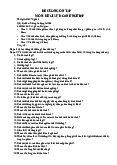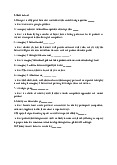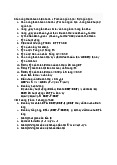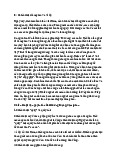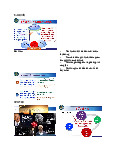














Preview text:
Strategy implementation: Level of strategy Corporate strategy:
- Outlines general overall strategy
- Defines markets it will operate it
- Plans how these markets will be entered BOD, Presidents, CEO: to direction of the firm Corporate level strategies: Diversification Strategy:
+ Related: expansion of new products or services which are the same on in-line with the current operations
+ Unrelated: value chain activities are not similar
Vertical integration Strategy & Horizontal Integration Strategy:
+ Forward Integration: increase control over distributors or retailers
Ex: franchise = agreement provides the control
+Backward Integration: increase control over suppliers Ex: Suppliers are unreliable Consolidation Strategy Geographic Expansion Strategy
Defensive strategy: faced difficulties insufficient resources
- Retrenchment strategy: regroup employees, reoganizaion, closing of marginal business + Turn around
+ Divestment or divestitute: when company want to race additional capital
+ Liquidation: "defeat", stoppage of operation Intensive strategies:
+ Product development: introduce a new product line Modify existing product
+ Market development: new geographic areas
+ Market penetration: increase market share Business Strategy level: Uses corporate strategy to:
Define specific tactics for each market
+ Cost leadership: focus on standarded product, price sensitive consumer, low cost, best value
+ Differentiation: operating unique product
Focused strategy: products are sold to specific consumer
STRATEGIC EVALUATION & CONTROL
1. Review factors or Set of standard: profitable, market leadership, productivity
2. Measure of performance = profitability = 3% 3. Corrective action
Organizational Control: guide the use of strategy, indicate how to compare actual with
expected results, and suggest corrective actions to take when the difference is unacceptable
Organizational control measures Criteria:
1. Consistency: goals and objectives
2. Consonãnce: trends of enviroment
3. Feasibility: applicable = resource
4. Advantage: benefits must be higher than cost Balance Scorecard:
1. Financial: revenue, expenses, return on investment
2. Customer perpective: customer loyalty, customer sastifaction
3. Learning of growth: training development skills, employees retension
4. Internal processes: quality control, inventory control Types of strategic control:
+ Premise control: continuously analyze the premise
Environmental factors, industry factors
+ Strategic surveillance: => events inside => outside the firm
+ Strategic Special alert: sudden unexpected incident
+ Implementation control: slight changes may occur Financial control tools: • Financial ratios • Budgeting: quantitative Documents that detail the use of funds Good corporate governance:
- describe how the firm manage its relationship with the stakeholders
=> maintain the harmony between parties with conflicts
Transparency (of operations): openness and willingness to share information
Accountability (towards shareholders): responsibility, expected and answerable in explaining to the results
Fairness (in dealings): equal treatment => provide equal opportunity to all
stakeholders to voice out their issues rubrics
Quiz 1: Introduction to Strategic Management
1. Which of the following statements describe the firm's sustained competitive advantage?
A. Effective formulation, implementation, and evaluation
B. Continuously improve competence and resources
C. The firm can maintain excellent performance for several years.
D. Strive to identify and secure the most promising market segment
2. Which among the phases of strategic planning can be used by the manager when
they want to know if the strategies performed well or not? A. Strategy formulation B. Strategy implementation C. Strategy evaluation D. Strategy control
3. Which among the following statements is an essential activity under strategy evaluation?
A. Requires top management decisions B. Measuring performance
C. Determines the firm's competitive advantage
D. Determines the strengths and weaknesses of the firm
4. Which among the following statements is TRUE with reference to functional level strategy?
A. Address issues on efficiency and effectiveness of marketing
B. Strive to identify and secure the most promising market segment
C. Determine the firm's directions
D. Exploit the firm's distinct competencies
5. Which of the statements given below is an advantage of strategic planning?
A. Develop annual objectives and short-term strategies
B. Evaluate the success of the strategic process as an audit for future decision making.
C. Improve understanding of the rapidly changing environment
D. Involves the recognition of trade-off between efficiency and effectiveness
6. Who among the following stakeholders is interested on the firm's ability to pay short-term obligation? A. Customers B. Suppliers and creditors C. Employees D. Owners and investors
7. Which of the following choices describes the statements given below?
Statement 1: A firm enjoys its competitive advantage over its rivals when its
profitability is greater than its last year of operation.
Statement 2: A firm use its strategies as a guide to decision making and address any of its recurring situations. A. Both statements are correct
B. Both statements are incorrect
C. First statement is correct, and the second statement is incorrect
D. First statement is incorrect, and the second statement is correct.
8. Which of the following statements is considered as a characteristic of strategic management?
A. Develop annual objectives and short-term strategies
B. Evaluate the success of the strategic process as an audit for future decision making.
C. Improve understanding of the rapidly changing environment
D. Involves the recognition of trade-off between efficiency and effectiveness
9. Which among the following terminologies refers to the set of actions that managers
implement to increase the firm's competitive advantage? A. Plans B. Strategies C. Policies D. Procedures
10. What phase of strategic planning allows the manager to conduct environment scanning? A. Strategic evaluation B. Strategic control C. Strategy formulation D. Strategy implementation
11. Who among the following stakeholders is concerned with the quality and reliability of a firm's product? A. Consumer B. Suppliers C. Creditors D. Employees
12. Which among the following skills of a manager is important in strategy formulation? A. Decisional B. Technical C. Conceptual D. Interpersonal
13. What phase of strategic management covers the issues on the allocation of
resources and decisions to enter international markets? A. Strategy formulation B. Strategy implementation C. Strategy evaluation D. Strategy control
14. Which among the skills of a manager is essential for strategic implementation? A. Decisional B. Technical C. Conceptual D. Interpersonal
15. What level of strategy is used to determine how the firm will compete in the selected market? A. Corporate level strategy B. Operational level strategy C. Functional strategy D. Business level strategy
16. Which of the components of the mission statement relates to how the firm shows its response to A. B. Pubilc image C. Self-concept D. Philosophy
17. This component of the mission statement indicates the firm's concern for financial soundness? A. Market B. Product C. Technology D. Survival and growth
18. This is a statement that describes the attitude of the firm? A. Philosophy B. Vision statement C. Mission statement D. Objective
19. Which among the following company statements defines the future direction of the firm? A Philosophy B. Vision statement C. Mission statement D. Objective
20. Which among the following scenarious describe the degree that a small number of
firms deminate a potential market ? A. Entry barriers B. Environmental scanning C. Product differentiation D. Market concentration
Quiz 4: Strategy Formulation: Environmental analysis
1. Which among the following general environment is focused on the firm's effort to
develop and use renewable energy? A. Physical environment B. Socio-cultural environment C. Technological environment D. Economic environment
2. Which of the following situations must be considered by the firm in assessing socio-cultural environment? A. Personal savings rate B. Product innovations C. Workforce diversity D. Important political event
3. The step in external environment analysis that establishes estimates based on the
results of external audit is called? A. Assessing B. Forecasting C. Monitoring D. Scanning
4. Which among the components of the mission statement relates to Royal Caribbean's
"we are committed to act in the highest ethical manner and respect the rights and dignity of others"? A. Self-concept B. Public image C. Concern for employees D. Philosophy
5. Which of the following choices describes the statements given below?
Statement 1: The threat of new markets is high when the firm tries to maximize the use of productive capacity.
Statement 2: Competitive/industry rivalry is high when the firm experience a high cost for exit barriers. A. Both statements are correct
B. Both statements are incorrect
C. First statement is correct, second statement is incorrect
D. First statement is incorrect, second statement is correct
6. Which among the components of the mission statement describes Samsung "to
contribute to a better global society"? A. Public image B. Self-concept C. Philosophy D. Market
7. Which among the components of the mission statement describes Vietnam Airline's
"to provide quality aviation services in accordance with international standards"? A. Public image B. Philosophy C. Self-concept D. Technology
8. Which among the components of the mission statement relates to Apple's "through
its innovative hardware, software, and services"? A. Product B. Technology C. Self-concept D. Survival and growth
9. Which of the following choices describes the statements given below?
Statement 1: The PORTER five forces is a business framework that analyzes the
financial soundness of an industry.
Statement 2: The PESTLE analysis is a framework that identifies the profit potential
in an industry and shape's a firm competitive strategy. A. Both statements are correct
B. Both statements are incorrect
C. First statement is correct, second statement is incorrect
D. First statement is incorrect, second statement is correct
10. Which among the purposes of environmental scanning identifies the hindrances
and challenges of a potential industry? A. PESTEL analysis B. Market concentration C. Entry barrier D. Product differentiation
11. Which of the components of the mission statement relates to how the firm shows
its response to social, community and environmental concerns? A. Employees B. Public image C. Self-concept D. Philosophy
12. This component of the mission statement indicates the firm's concern for financial soundness? A. Market B. Product C. Technology D. Survival and growth
13. Which of the following choices describes the statements given below?
Statement 1: The bargaining power of supplier is manifested in situations wherein
buyers are after numerous choices.
Statement 2: The threat of substitute products is observed in the industry when the
quality of the competitors product is better. A. Both statements are correct
B. Both statements are incorrect
C. First statement is correct, second statement is incorrect
D. First statement is incorrect, second statement is correct
14. Which among the following company statements defines the future direction of the firm? A. Philosophy B. Vision statement C. Mission statement D. Objective
15. Which among the following scenarios describe the degree that a small number of
firms dominate a potential market? A. Entry barriers B. Environmental scanning C. Product differentiation D. Market concentration
16. Which among the general environment factors is concerned with the society's
attitude toward foreign people and racial equality? A. Demographic B. Economic C. Socio-cultural D. Physical environment
17. Which of the following general environment assessment describes the processes
and actions of the government bodies that will result to laws, mandates, and regulations? A. Political-legal B. Economic C. Socio-cultural D. Ecological
18. Which among the components of the mission statement relates to Unilever's "act
with the highest levels of corporate behavior"? A. Self-concept B. Public image C. Concern for employees D. Philosophy
19. Which among the components of the mission statement describes Mc Donald's
"consistent taste and price in a low décor and friendly atmosphere"? A. Self-concept B. Public image C. Concern for employees D. Philosophy
20. Which among the components of the mission statement is align with Fleetwood
Enterprises" "we will lead our industries in the application of appropriate technologies"? A. Survival and growth B. Market C. Technology D. Customers Quiz 7 Internal Analysis
1. What type of tangible resource is linked with the firm's formal reporting structure? A. Financial resource B. Technology resource C. Organizational resource D. Physical resource
2. Which of the following managerial activities is an essential bridge between the
present and the future of the firm? A. Organizing B. Planning C. Leading D. Controlling
3. Which among the criteria of competitive advantage allows the firm to explore
opportunities in its external environment? A. Costly to imitate B. Non-substitutable C. Rare D. Valuable capabilities
4. Which among the following is NOT a building block of the firm's competitive advantage? A. Internal audit B. Resources C. Capabilities D. Core competencies
5. What managerial activity is composed of work specialization, departmentalization and delegation? A. Organizing B. Planning C. Leading D. Controlling
6. What criteria of competitive advantage is brought about by unique historical conditions? A. Costly to imitate B. Non-substitutable C. Rare D. Valuable capabilities
7. Which of the following choices describe the statements given below?
Statement 1: Selling products and services encompasses product options, features, styles, and quality.
Statement 2: Opportunity analysis involves an analysis of the threat associated with the marketing decision. A. Both statement is correct B. Both statement is incorrect
C. First statement is correct, and second statement is incorrect
D. First statement is incorrect, and second statement is correct
8. What type of tangible resources covers the firm's ability to generate internal funds? A. Physical resources B. Technology resources C. Financial resources D. Organizational resources
9. What managerial activity is directed towards ensuring that actual results are
consistent with planned results? A. Organizing B. Planning C. Leading D. Controlling
10. Which among the foundations of competitive advantage emerges overtime through
accumulating and learning how to deploy organizational wealth? A. Internal audit B. Resources C. Capabilities D. Core competencies
11. What managerial function is centered on managing human resources such as recruitment and selection? A. Controlling B. Staffing C. Organizing D. Planning
12. What marketing activity involves an analysis of cost, benefit and risk associated with marketing decisions? A. Customer analysis B. Pricing analysis C. Opportunity analysis D. Distribution
13. Which among the following resources is associated with knowledge and organizational routines? A. Reputational resource B. Human resource C. Organizational resource D. Physical resource
14. What marketing decision made by the firm affect all the stakeholders, but such
decision is important in pursuing forward integration strategy? A. Consumer analysis B. Distribution C. Pricing decision D. Opportunity analysis
15. Which of the following statements is/are correct?
Statement 1: The cash cow quadrant in the BCG matrix describes the ability of the
firm to compete in a high growth industry maximizing its high market share.
Statement 2: The aggressive quadrant of the SPACE matrix indicates an excellent
position of the firm to maximize its strength.
Statement 3: The Strength - Opportunity matching in the SWOT matrix emphasizes
the use of resources to exploit favorable conditions of the environment. A. Statement 1 and statement 2 B. Statement 1 and statement 3 C. Statement 2 and statement 3
D. Statement 1, statement 2, and statement 3
